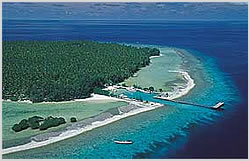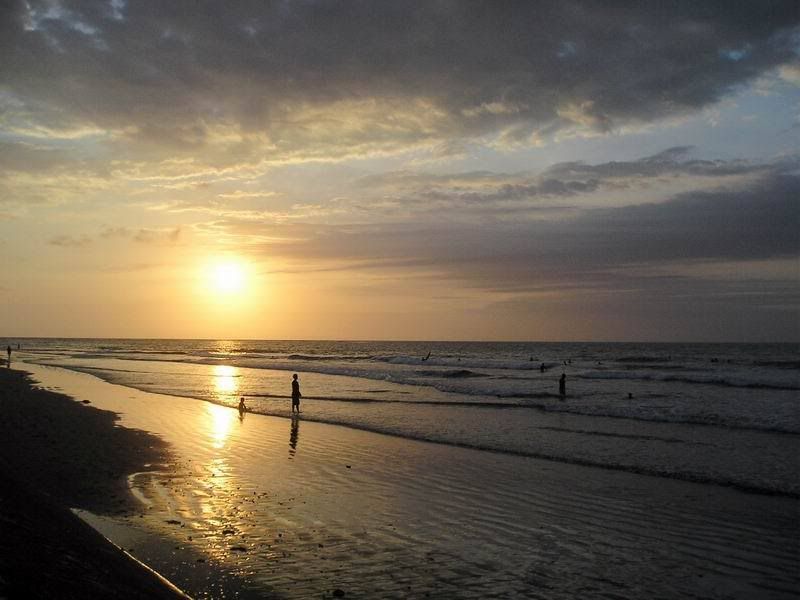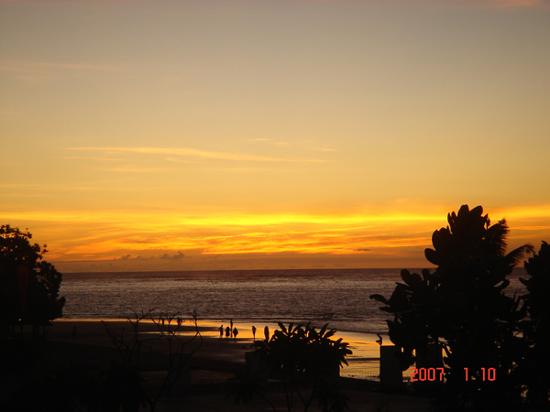TAMAN NASIONAL LAUT KEPULAUAN KARIMUNJAWA

Kawasan ini terletak di laut Jawa + 83 km dari Kota Jepara menuju arah utara. Obyek ini merupakan kepulauan yang ditetapkan sebagai Taman Nasional laut Karimunjawa. luas daratan 7.120 Ha dengan pulau berjumlah 27 buah, namun yang berpenghuni hanya 5 buah. yaitu Karimunjawa, Kemujan, Parang, Nyamuk dan Genting. dengan hamparan pemandangan di sela-sela pulau, pasir putih yang membentang di sepanjang pantai dengan pohon kelapa. Terdapat 242 jenis ikan hias, serta 133 genera fauna akuatik. Dengan kapal motor, karimun jawa dapat ditempuh dalam waktu sekitar 5 jam dari dermaga Jepara. Di kawasan Taman Nasional laut ini juga telah dibangun "Kura-Kura Resort" yang merupakan kawasan peristirahatan dengan fasilitas lux, yang merupakan milik investor asing.
Secara garis besar fauna yang ada di Kepulauan Karimunjawa terdiri dari 2 (dua ) kelompok, yaitu :
1. Daratan : Rusa, Trenggiling, Landak, Ular, Bangau Tong tong, Bangau Abu-abu, Elang laut dan Wedi-wedi. Burung elang laut merupakan satwa langka yang dapat dijumpai di kepulauan ini.
2. Perairan : Terumbu karang, spons, karang lunak, akar bahar, kerang merah, penyu dan ikan hias. Pantai-pantai di Karimunjawa sebagian besar berpasir putih, oleh karena itu cocok untuk kegiatan berjemur, menyelam dan memancing.
Kegiatan wisata yang dapat dilakukan di Karimunjawa :
1. Olah raga selam, bagi yang hobi menyelam dapat menyalurkan hobinya di Tanjung Gelam ( di Karimunjawa ), Pulau Menjangan Kecil dan Pulau Cemara Kecil.
2. Mandi di Pantai dan Berjemur, cocok dilakukan di Pulau Menjangan Besar yang berpasir putih dan Pulau Cemara Kecil.
3. Snorkeling, di berbagai spot yang memberikan pemandangan bawah laut yang mengagumkan.
4. Memancing, para hobiist mancing dapat menyalurkan hobinya dengan menyewa kapal.
menyewa kapal.
5. Glass bottom boat, bagi yang tidak bisa berenang bisa menikmati keindahan bawah laut dng glass bottom boat.
6. Jetski dan banana boat, bagi yang menyukai olah raga air ini, dapat melakukannya di karimunjawa.
7. Penangkaran ikan hiu, mencoba merasakan fear factor disini, bercanda dengan hiu.
8. Berperahu mengunjungi pulau-pulau, banyaknya pulau-pulau yang indah, dapat anda kunjungi dengan menggunakan perahu.
9. Ziarah dimakam Sunan Nyamplungan.
10. Menyelami kehidupan tradisi nelayan Bugis dan Madura dng rumah khas panggungnya.
Menuju KARIMUNJAWA dapat ditempuh dengan kapal cepat Kartini I dari Semarang Setiap hari Sabtu dan Senin setiap 2 minggu sekali, dari Jepara setiap hari Senin 2 minggu sekali. Dng KM. Muria dari Jepara setiap hari Rabu dan Sabtu, dapat pula dng jalur penerbangan dari bandara A. Yani Semarang dengan pesawat charter jenis CASSA 212 sekitar 30 menit sampai bandara Dewadaru Karimunjawa. Telah tersedia sarana akomodasi yg cukup memadai mulai home stay, resort dan hotel
Legenda Nyamplungan
Nama Karimun menurut cerita rakyat setempat tidak terlepas dari sosok sunan Nyamplung, yang bernama asli Syech Amir Hasan, putera dari sunan Muria. Sedari kecil, ia hidup dimanja sehingga ketika beranjak dewasa, ia menjadi cenderung nakal. Sunan Muria sudah berusaha mendidik puteranya tersebut agar menjadi lebih baik, tetapi selalu gagal. Akhirnya sunan Muria menitipkan puteranya kepada sunan Kudus, dengan harapan menjadi lebih baik.
Di bawah bimbingan sunan Kudus, Amir Hasan memang menjadi pribadi yang lebih baik dan taat, sehingga ia dikembalikan kepada keluarganya. Tetapi setelah berkumpul kembali dengan keluarganya, perilaku Amir Hasan kembali seperti semula.
Sunan Muria merasa prihatin, dan akhirnya memerintahkan puteranya tersebut untuk turun gunung Muria dan mengamalkan ilmu agama di pulau yang nampak "kremun-kremun" (tidak jelas) bila dilihat dari gunung Muria. Dan sunan Muria pun mengatakan bahwa Amir Hasan tidak boleh kembali ke pulau Jawa sebelum tugasnya selesai.
Dengan berbekal 2 buah biji Nyamplung untuk ditanam di pulau tujuan, dan mustaka masjid (sampai saat ini masih berada di kompleks makam sunan Nyamplungan), serta ditemani oleh 2 orang abdi, akhirnya Amir Hasan pun memulai perjalannya. Setelah sampai dan menemukan tempat yang cocok untuk ditinggali, Amir Hasan kemudian menanam 2 buah biji Nyamplung yang dibawanya dari pulau Jawa. Tanaman yang tumbuh dari kedua biji Nyamplung inilah yang sekarang dikenal sebagai pohon Nyamplung, dan lokasinya diberi nama dukuh Nyamplung.










 East Nusa Tenggara Islands have been shaped by the power and force of an enormous chain of mountains and volcanoes, which begins from the North of Sumatra and stretches east across Java. The province consists of over 550 islands, but is dominated by the three main islands of Flores, Sumba, and Timor. Occupying a unique position at the junction of Australian and Asian submarine ridges marked by the Wallace Line, it is one the world's most dynamic and exotic marine environments with nearly every species of coral and tropical fish represented. The arid landscape of eastern and southeastern Nusa Tenggara is the result of hot, dry winds blasting in from the Australian continent. In fact, in many coastal areas not a drop of rain falls during most of the year.
East Nusa Tenggara Islands have been shaped by the power and force of an enormous chain of mountains and volcanoes, which begins from the North of Sumatra and stretches east across Java. The province consists of over 550 islands, but is dominated by the three main islands of Flores, Sumba, and Timor. Occupying a unique position at the junction of Australian and Asian submarine ridges marked by the Wallace Line, it is one the world's most dynamic and exotic marine environments with nearly every species of coral and tropical fish represented. The arid landscape of eastern and southeastern Nusa Tenggara is the result of hot, dry winds blasting in from the Australian continent. In fact, in many coastal areas not a drop of rain falls during most of the year. Flores is a Portuguese name, which means 'flower' and ideally describes the beauty to be found here. This long island between Sumbawa and Timor is crowded with volcanoes and mountains dividing it into several distinct regions with individual languages and traditions. Predominantly Catholic and heavily influenced by the Portuguese, there are many examples of a strong European cultural heritage like eastern procession held in Larantuka, and the royal regalia of the former king in Maumere.
Flores is a Portuguese name, which means 'flower' and ideally describes the beauty to be found here. This long island between Sumbawa and Timor is crowded with volcanoes and mountains dividing it into several distinct regions with individual languages and traditions. Predominantly Catholic and heavily influenced by the Portuguese, there are many examples of a strong European cultural heritage like eastern procession held in Larantuka, and the royal regalia of the former king in Maumere.  take place, such as 'Pasola' where hundreds of horsemen fling spreads at each other in an annual ritual. Many traditional ceremonies, all with a component paying homage to the spirits, take place from July to October including the traditional houses and burials when sometimes hundreds of pigs, water buffaloes, horses, and dogs are scarified. Other ceremonies include 'Pajura' or traditional boxing, festivals for the Lunar New Year in October and November, horse races and ritual dances.
take place, such as 'Pasola' where hundreds of horsemen fling spreads at each other in an annual ritual. Many traditional ceremonies, all with a component paying homage to the spirits, take place from July to October including the traditional houses and burials when sometimes hundreds of pigs, water buffaloes, horses, and dogs are scarified. Other ceremonies include 'Pajura' or traditional boxing, festivals for the Lunar New Year in October and November, horse races and ritual dances. The Wallace Line, named after 19th century naturalist, Alfred Russell Wallace, marks a point of transition between the flora and fauna of Western and Eastern Indonesia and acts as the Western boundary of West Nusa Tenggara, which includes Lombok Island and Sumbawa. Lombok is noticeably different to its close neighbor, Bali. The northern part of the island is mountainous and lush with tall trees and shrubs. The South on the other hand is arid and covered by savannas. Large Asian mammals are absents and replaced instead by large numbers of marsupials, lizards, cockatoos and parrots. The difference becomes more pronounced as one moves further east where dry seasons are more prolonged and the land is dry and bush-like, and so in many areas corn and sago are the staple food, instead of rice. At first Islam time come to these islands in the 16th century, four Hindu Kingdoms co-existed in apparent peace what is now called West Nusa Tenggara and is still the religion embraced by those in the west of Lombok, which are primarily Balinese. Lombok experienced strong Balinese influences in the past, but has still retained a unique identifies. The indigenous people of Lombok, the Sasaks, are predominantly Moslem and have a strong, distinguished tradition, as do the people of neighboring Sumbawa. Soft white sand, virgin beaches are typical in Lombok, where the motto is 'You can see Bali in Lombok, but not Lombok in Bali'. Famous for its 'tenun ikat' hand-woven textiles, the island has exceptional charm and its relatively undiscovered, except for Senggigi City, which becoming a major resort area. Regulars shuttle flights from Bali and Surabaya as well as ferries provide excellent transportation links within the islands of the province as well as with the rest of the country.
The Wallace Line, named after 19th century naturalist, Alfred Russell Wallace, marks a point of transition between the flora and fauna of Western and Eastern Indonesia and acts as the Western boundary of West Nusa Tenggara, which includes Lombok Island and Sumbawa. Lombok is noticeably different to its close neighbor, Bali. The northern part of the island is mountainous and lush with tall trees and shrubs. The South on the other hand is arid and covered by savannas. Large Asian mammals are absents and replaced instead by large numbers of marsupials, lizards, cockatoos and parrots. The difference becomes more pronounced as one moves further east where dry seasons are more prolonged and the land is dry and bush-like, and so in many areas corn and sago are the staple food, instead of rice. At first Islam time come to these islands in the 16th century, four Hindu Kingdoms co-existed in apparent peace what is now called West Nusa Tenggara and is still the religion embraced by those in the west of Lombok, which are primarily Balinese. Lombok experienced strong Balinese influences in the past, but has still retained a unique identifies. The indigenous people of Lombok, the Sasaks, are predominantly Moslem and have a strong, distinguished tradition, as do the people of neighboring Sumbawa. Soft white sand, virgin beaches are typical in Lombok, where the motto is 'You can see Bali in Lombok, but not Lombok in Bali'. Famous for its 'tenun ikat' hand-woven textiles, the island has exceptional charm and its relatively undiscovered, except for Senggigi City, which becoming a major resort area. Regulars shuttle flights from Bali and Surabaya as well as ferries provide excellent transportation links within the islands of the province as well as with the rest of the country.